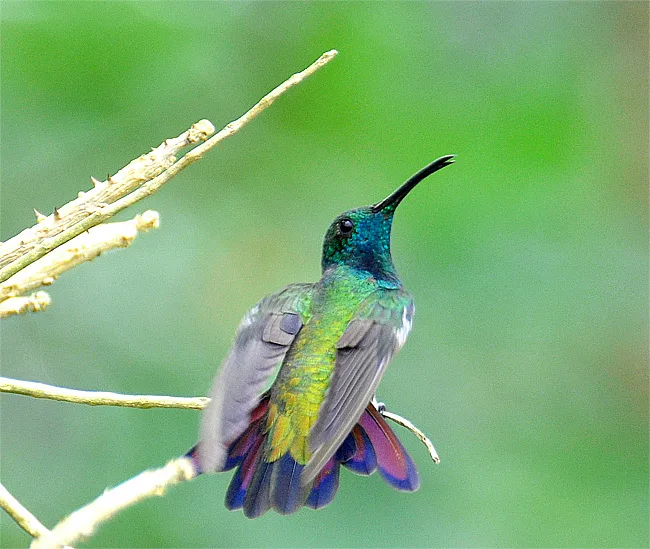 green-throated mango [order] Apodiformes | [family] Trochilidae | [latin] Anthracothorax viridigula | [UK] Green-throated Mango | [FR] Mango a cravate verte | [DE] Smaragdkehl-Mangokolibri | [ES] Mango Gorgiverde | [IT] Mango golaverde | [NL] Groenkeelmango SubspeciesMonotypic species Physical charateristicsThe male has glossy bright green upperparts with a copper tinge, especially on the rump. His throat and underparts are green with a black central line on the breast and belly. The tail has dark central feathers, the outer tail being wine-red tipped with black. The female Green -throated Mango has more bronze on the upperparts and flanks. She has white underparts with a black central stripe. The tail has dark central feathers, the outer tail being wine-red tipped with white. Immature males resemble females but have chestnut sides. Listen to the sound of Green-throated Mango [audio:http://www.aviflevoland.nl/sounddb/G/Green-throated Mango.mp3]
RangeThe Green-throated Mango breeds from northeastern Venezuela, Trinidad and the Guianas south to northeasterm Brazil. It is a local or seasonal migrant HabitatThis small bird inhabits mangrove swamp and moist lowland savannah. ReproductionThe female Green -throated Mango lays two white eggs in a deep cup nest on a high (10 meter), thin, and usually bare branch. The eggs are incubated by the female for about 15 days. The young fledge after about 25 days and will remain with the adults for another month. Feeding habitsThe food of this species is nectar, often taken from the flowers of large trees. This hummingbird is also notably insectivorous, often hovering in open areas to catch flying insects. ConservationThis species has a large range, with an estimated global extent of occurrence of 1,200,000 km2. The global population size has not been quantified, but the species is not believed to approach the thresholds for the population size criterion of the IUCN Red List (i.e., less than 10,000 mature individuals in conjunction with appropriate decline rates and subpopulation qualifiers), even though the species is described as ‘uncommon’ in at least parts of its range (Stotz et al. 1996). Global population trends have not been quantified, but the species is not believed to approach the thresholds for the population decline criterion of the IUCN Red List (i.e., declining more than 30% in ten years or three generations). For these reasons, the species is evaluated as Least Concern.  MigrationSedentary along coast, inland it follow the flowering of trees. Distribution map |
]]>
